New Year, new me, right? The most stereotypical New Year’s resolution is to improve your health. Maybe it’s quitting a bad habit, or losing weight, and for some, gaining weight.
With that in mind, how do you carry while exercising? For a lot of people, the idea of carrying while working out just seems silly.
If that’s your prerogative, that’s fine, but some of us tend to be more cautious and more prone to wanting to carry as much as possible.
Plus, gym lockers are often targets for theft, and leaving a gun in a vehicle is often a bad idea without a dedicated safe. That means the gun stays at home during your entire trip to the gym, or you risk getting it stolen.
THE QUICK LIST
-
Best Chest Rig
-
Best Fanny Pack
-
Best Belly Band
-
Best Pocket Holster
-
Best CCW Clothing
-
Best Complete Carry System
Table of Contents
Loading…
Why You Should Trust Us
I’ve spent a lifetime shooting that started in a family that hunted every season they legally could. From there, I joined the United States Marine Corps and spent five years as an infantryman.
In the middle of my Marine Corps career, I began writing and have never stopped. I soon earned my NRA instructor certification.
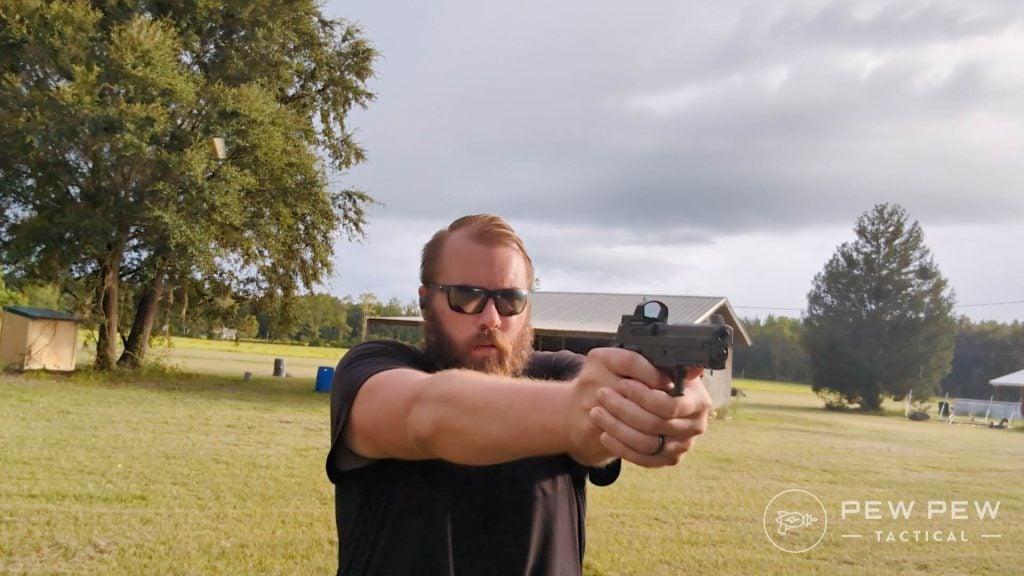
I love shooting, and I love guns — weird guns, old guns, new guns, tactical guns, you name it. I’m a continual student of firearms, and I strive to educate myself to provide the best information possible to the readers of Pew Pew Tactical.
I really started carrying after I went for a run and was chased by a pit bull. A big, mean one that gained on me quick enough that I had to jump a gate into a neighbor’s yard to get away from it.
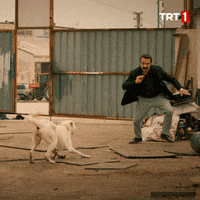
Since then, packing a small handgun and some Pom has been my priority, even when I’m just running through my neighborhood.
I also like to lift weights, so I’ve tried numerous methods to accommodate carrying while working out. I experimented and found out there wasn’t always a universal means to carry for every type of exercise.
Quick Tips When Exercising with a Gun
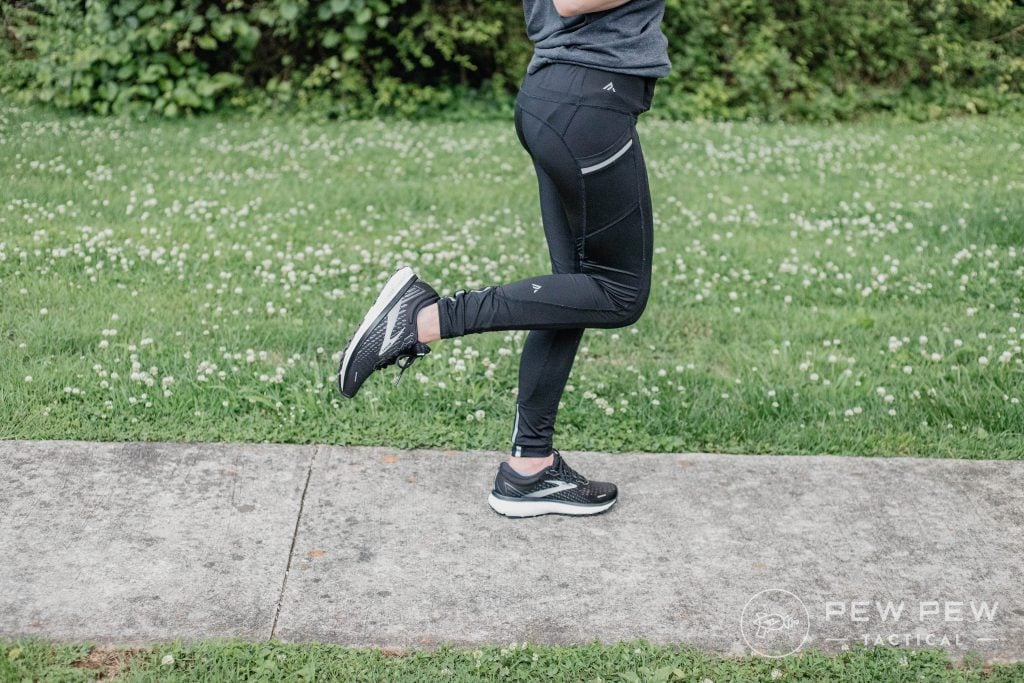
Before we jump into our recommendations, let’s look at a few things to think about. In general:
- Different types of exercise require different carry solutions.
- Baggier shirts are better for concealment purposes.
- Sweat is a cruel mistress, so wipe down your gun if exposed to sweat.
- Smaller guns are so much more comfortable while exercising.
- Adjustable passive retention might need to be cranked up, or you might need to use something with an active retention device.
- Yes, it’s always going to rub.
With all that out of the way, let’s break down some better fitness carry methods.
Best Ways to Concealed Carry While Exercising
1. 5.11 tactical Skyweight Utility Chest Pack
Prices accurate at time of writing
Prices accurate at time of writing
-
25% off all OAKLEY products - OAKLEY25
Copied! Visit Merchant
Pros
- Gun is not exposed to sweat
- Not dependent on clothes
- Great for high-volume activities
Cons
- Doesn't come with a holster
- Slow draw
Chest bags are basically a fanny pack connected to your chest. They may have looked odd a few years ago, but they’ve become more common.
I’ve been using the Skyweight Chest Rig from 5.11 Tactical, and it’s been one of the tools I use quite often to carry while involved in physical activity. I got it right before Hurricane Idalia hit, and it became a constant companion as we cleared trees from roads and driveways with chainsaws.
From a fitness perspective, the chest bag is a fantastic option. But it doesn’t come with a holster. Instead, it sports a CCW compartment. I added a 5.11 Tactical holster to it, as you will still need a holster to encompass the trigger to prevent negligent discharges.
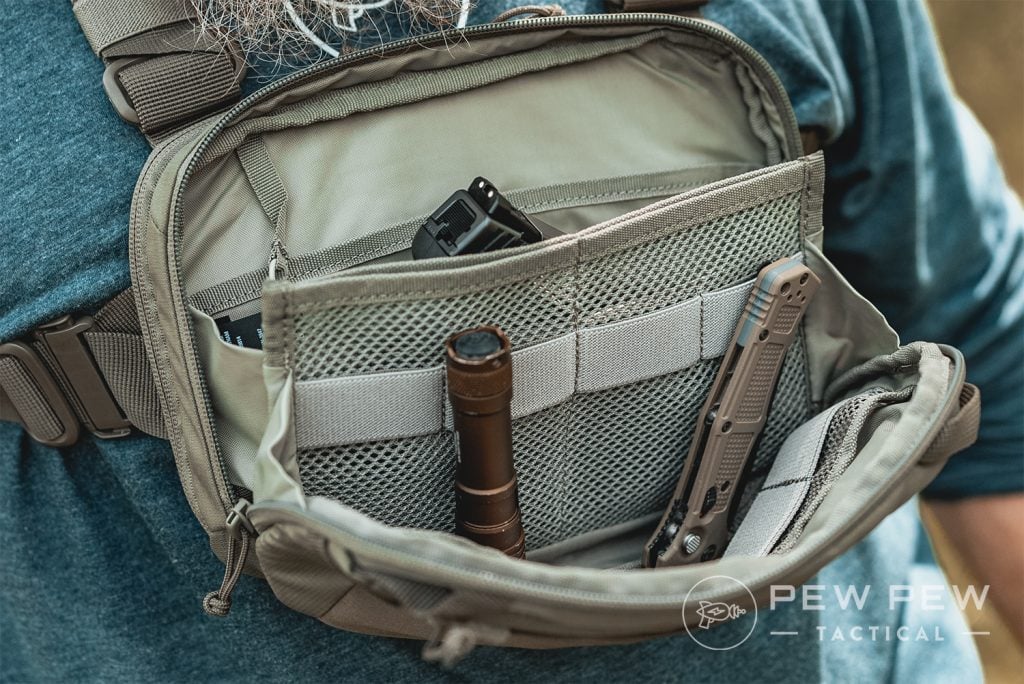
It’s great for high-volume activities with lots and lots of movement. The fact the internal holster has an active retention snap and that the chest rig itself zippers up means the gun stays put. Doing burpees, box jumps, and similar won’t reveal the gun.
For activities like running, it works well and, if properly tightened down, is quite comfy. The same goes for biking and other cardio activities.
It has total concealment, and you can carry a large gun. It fits my light-equipped Glock 19 well and doesn’t cause me any issues. It’s also protected from sweat.
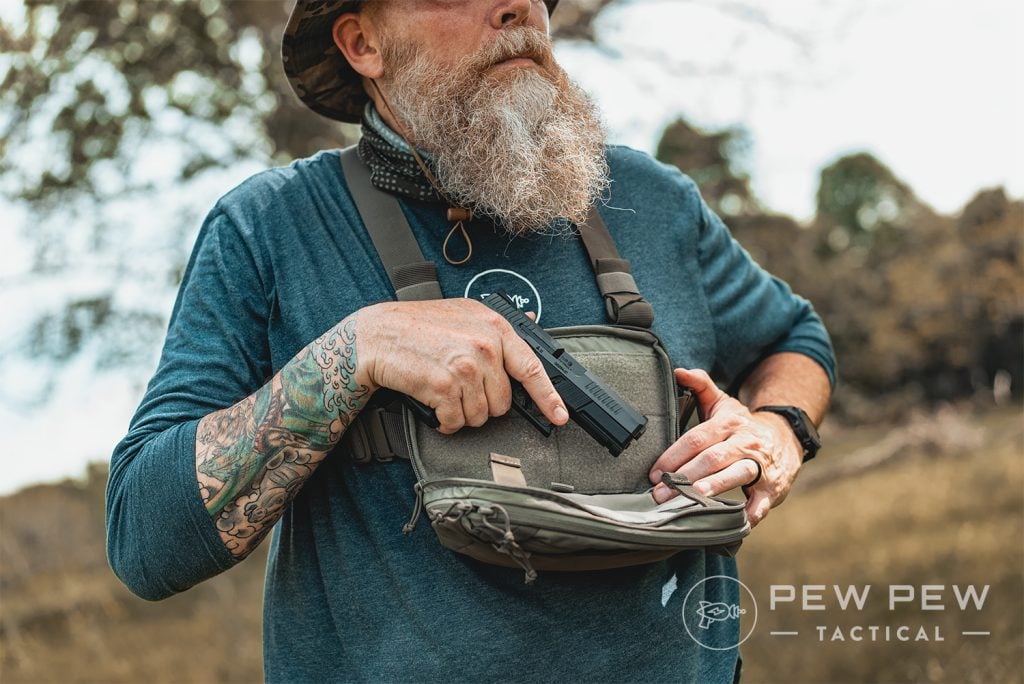
The Skyweight bag from 5.11 Tactical and the Runner’s Kit Bag from Hill People Gear both offer room to carry other stuff, like your phone, wallet, keys, earbuds, and even a less lethal option like Pom.
The downside is obviously a slow draw. The Skyweight bag has hot pulls to make unzipping nothing more than a quick jerk, but it’s still slower than a waist-based design. It also makes bench presses and push-ups challenging to get a full range of motion.
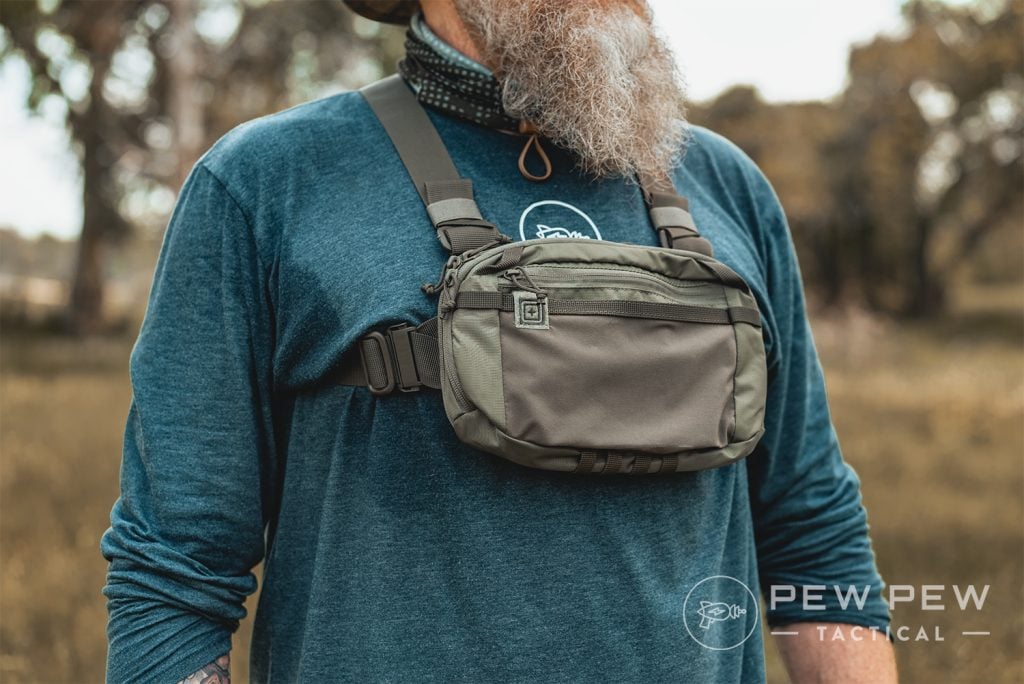
2. Vertx SCOP Tactical Fanny Pack
Prices accurate at time of writing
Prices accurate at time of writing
-
25% off all OAKLEY products - OAKLEY25
Copied! Visit Merchant
Pros
- More discreet than chest bag
- Total concealment of your gun
- Can carry full-size pistol
Cons
- Have to install holster
Fanny packs are making a total comeback. As a tactical dad, the fanny pack is awesome. For fitness and carry, it works similarly to the chest rig. I’d argue it’s less likely to get a second look than a chest rig and a bit more discreet.
Vertx makes one called the SOCP, which is a bit smaller and a little less tactical-looking. I do recommend a purpose-built tactical model that comes with or allows you to install a holster.
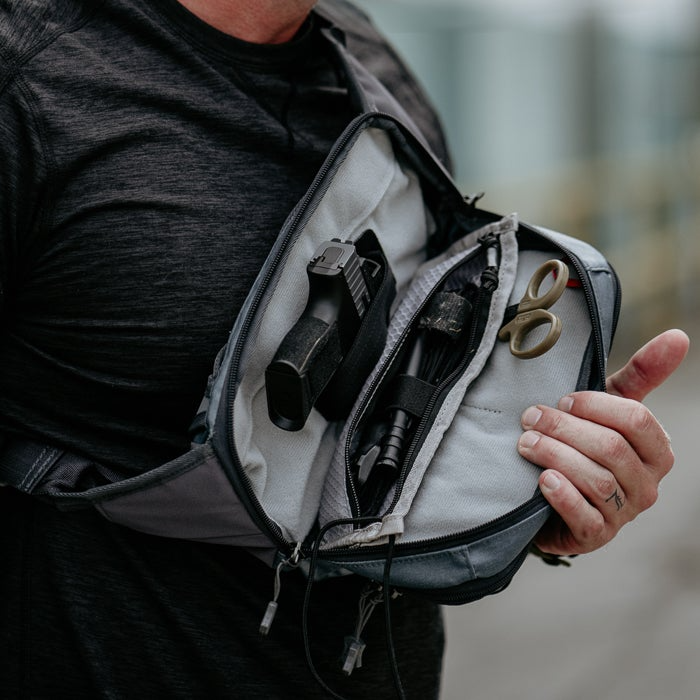
Fanny packs offer total concealment of your gun, and you can carry a large gun. With that said, the fanny pack has less support than the chest rig, and this can create discomfort depending on your activity.
If you’re lifting weights in a slow, controlled manner, then the weight of your gun doesn’t matter. If you’re riding the bike, then it’s the same thing. If you go for a run, it will start bouncing and bumping and be a real pain.
Swap the Glock for a Ruger LCP, and the problem disappears. The fanny pack can work for many fitness events, but your gun matters a little more. Fanny packs do total retention, so burpees won’t plop the gun out.
Prices accurate at time of writing
Prices accurate at time of writing
-
25% off all OAKLEY products - OAKLEY25
Copied! Visit Merchant
It’s also protected from sweat but is slow to draw. It requires a few extra motions to access your gun. Like the chest rig, this means more training is necessary.
3. Clip & Carry Strapt-TAC
-
25% off all OAKLEY products - OAKLEY25
Copied! Visit Merchant
Pros
- Affordable
- Can work for a variety of exercises
- Can carry accessories in sidecar pouch
Cons
- Exposes gun to sweat
- Can move around your body with lots of movement
Lastly, we have an affordable way to carry via Strapt-TAC. Strapt-TAC is my belly band solution for carrying at the gym.
The Strapt-TAC goes around your body like a belly band, but there is no holster. Instead, we have a pouch and a belt design for you to squeeze your IWB holster into. This pouch and belt portion is padded for comfort and support.
While the rest of the band is very minimalist, the pouch and gun portion are not. This provides rigid support and protection. You can move the Strapt-TAC up or down for belly carry or under the arm and low enough to be behind your shorts in a classic carry position.
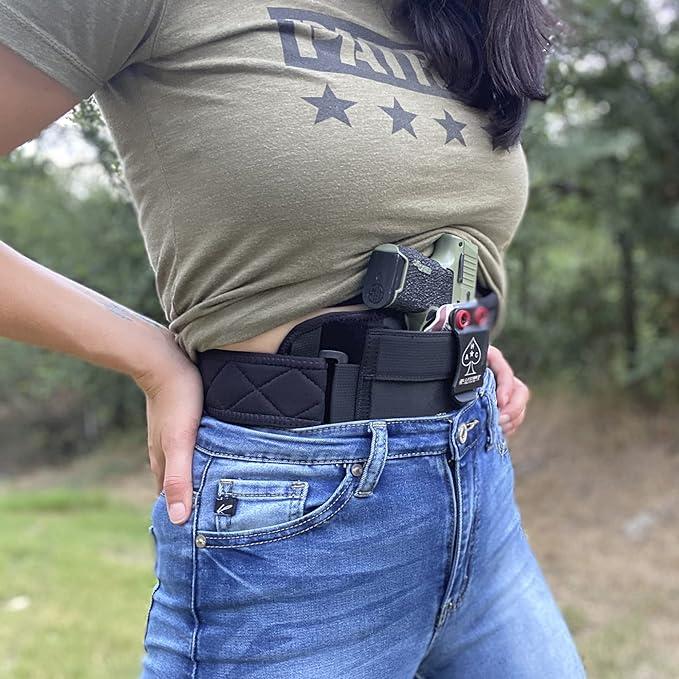
Like most belly bands, it can work for a variety of exercises. With a smaller gun, it’s even pretty decent for running. The downside is that it can move on you a bit, especially with high-volume movement activities.
As mentioned, it all rubs, so expect that as well. The Strapt-TAC has a couple of sizes, and the larger models can accommodate a sidecar holster or spare mag pouch. Personally, I think the large one is great because I really like carrying Pom as a less lethal option.
Your holster will more or less determine what you can or can’t do. As you’d imagine, the design does expose your gun to sweat, so be wary of that.
4. Desantis Super Fly Pocket Carry
Prices accurate at time of writing
Prices accurate at time of writing
-
25% off all OAKLEY products - OAKLEY25
Copied! Visit Merchant
Pros
- Best for lifting weights, stationary workouts
- Quick draw
- Easy access
Cons
- Not good for running
- Limited to small gun
Pocket carry is my general around-the-house method of carry, and it is one I have trained with and am familiar with. It turns out it translates to the gym pretty well.
With that said, it mostly sucks for running. I hate stuff in my pockets when I run and a gun flops around. Where pocket carry works is lifting weights and some cardio.
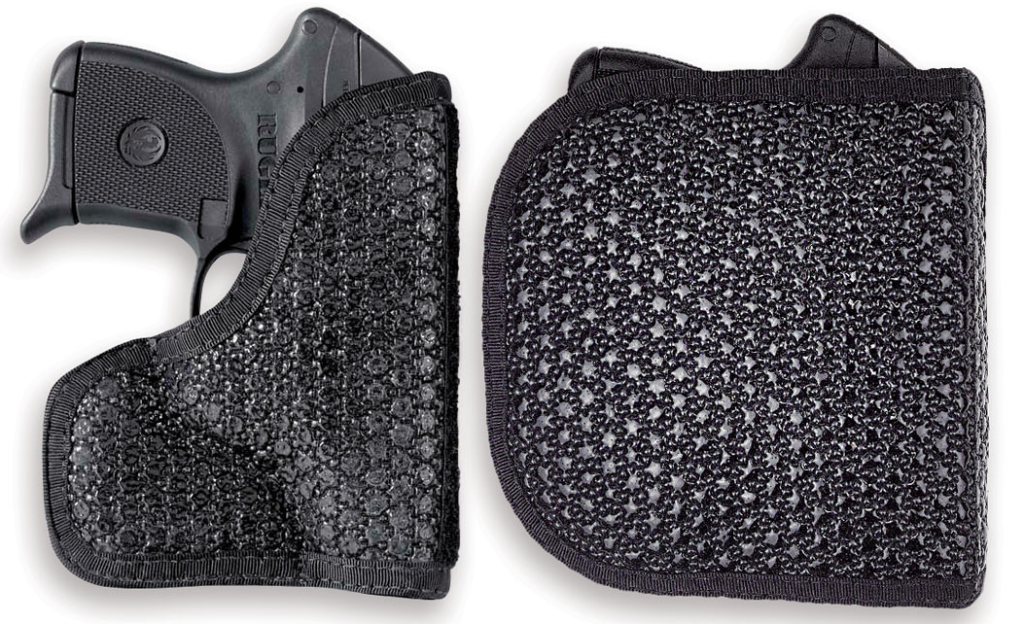
Using pocket carry on the stair stepper, bike, and rowing machine wasn’t a problem. Pocket carry still requires a holster and a good one at that.
It does limit you to a small gun. I tend to stick with a KelTec P32 because it is light and easy to carry, even in gym shorts. It’s very easy to conceal but is exposed to sweat, so be aware of that.
Prices accurate at time of writing
Prices accurate at time of writing
-
25% off all OAKLEY products - OAKLEY25
Copied! Visit Merchant
There are lots and lots of good options out there for pocket carry. I use the Desantis Superfly personally. The holster is large and fills the pocket, which keeps it from moving around in the pocket. It’s also equipped with a flap that breaks up the gun’s profile and keeps people from spotting it while printing.
Drawing is super quick and easy to do. If you detect a threat, you can pre-draw by simply putting your hand in your pocket and getting ready, just in case. It’s the least bulky method of carrying while working out and often the simplest. It just requires pockets.
Sadly, that doesn’t eliminate some options for women since someone decided they never need pockets.

5. Arrowhead Carrier Shorts
Prices accurate at time of writing
Prices accurate at time of writing
-
25% off all OAKLEY products - OAKLEY25
Copied! Visit Merchant
Pros
- Belt loop for belt + holster combo
- Perfect for IWB and AIWB
Cons
- Gun is exposed to sweat
- Will need multiple pairs or repeatedly wash one pair
I want to mention the carrier shorts as another option. They come in a few different lengths and styles, but as the name implies, they are designed for carrying.
Unlike most shorts, the carrier shorts have a special waistband. Arrowhead calls it the Carrier Retention Waistband. This waistband allows you to install a slim 1.5-inch belt in the waistband. You can install your own, but they also have an option to include their belt, which I’d suggest to ensure the belt fits and works with the shorts.
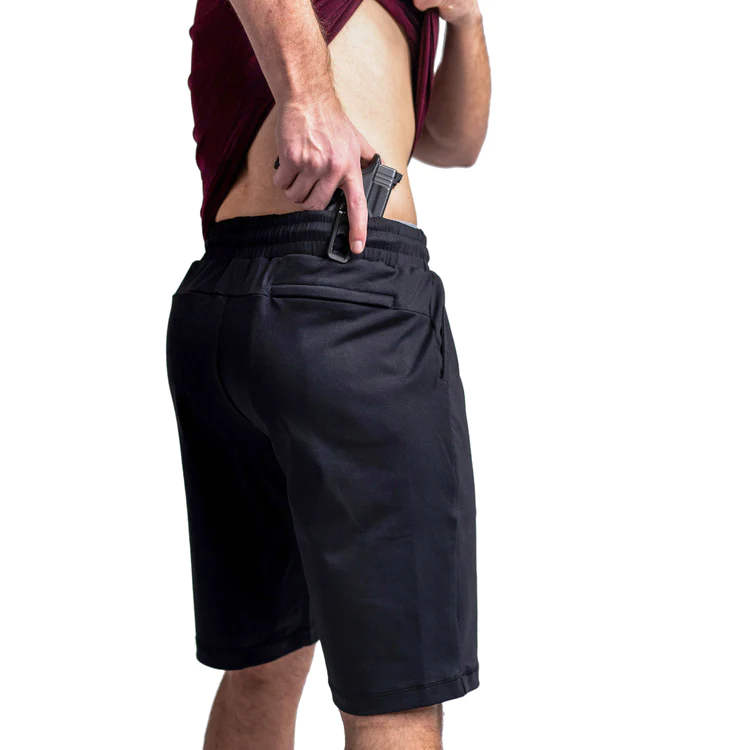
This integrated belt makes it easy to carry your standard loadout with the holster you carry every day. It allows for easy IWB and AIWB carry and deep concealment while wearing comfortable, flexible pants for working out.
Your holster will more or less dictate the activities you can do. Depending on your holster setup and its ability to retain your firearm, it might be tough to do burpees or sprints. The real benefit is just being able to carry what you always carry and what you’ve trained with, with little hassle. They are available for both men and women.
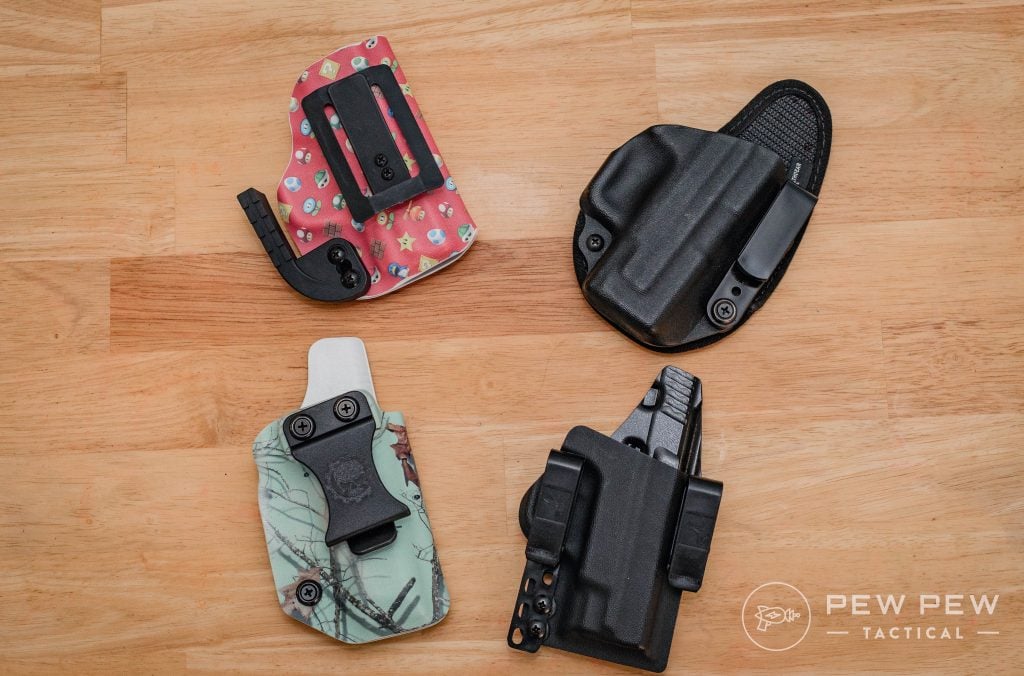
Your gun will be exposed to sweat, but it’s a fairly quick and easy draw. The real downside is the price. The shorts are super well made, but they are pricey. Since they are clothing, you’ll need to invest in multiple pairs or repeatedly wash one pair.
Or I guess you could just stink, but I don’t suggest that.
6. PHLster Enigma
Prices accurate at time of writing
Prices accurate at time of writing
-
25% off all OAKLEY products - OAKLEY25
Copied! Visit Merchant
Pros
- Don't need belt
- Works with a wider variety of clothes
- Compatible with a variety of holsters
Cons
- Gun is exposed to sweat
- Expensive
The PHLster Enigma isn’t a holster by itself but a carry system.
It acts as the platform to mount your holster and carry gun, eliminating the need for a belt or good pants. The Enigma can be worn with gym shorts, leggings, yoga pants, sweatshirts, or whatever, and is compatible with a variety of holsters, including PHLsters’ own as well as JM Custom Kydex, Henry Holsters, Dark Star Gear, and many more. This makes it easy to find the right holster for your gun, light, laser, and whatever else.
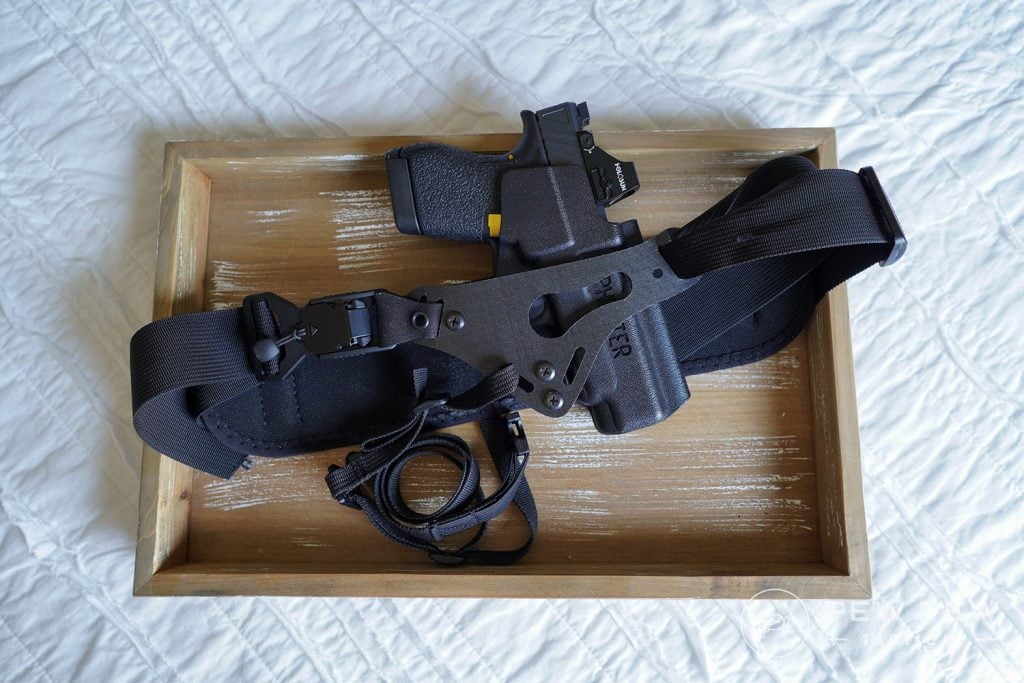
The Enigma series offers us the closest thing we can get to a universal option for concealed carry while working out. It works well for lifting weights, as well as running.
I’d stick with a small gun, like the Sig Sauer P365, when running. Being lighter and smaller is easier and more comfortable to carry as you put the roadwork in.
Prices accurate at time of writing
Prices accurate at time of writing
-
25% off all OAKLEY products - OAKLEY25
Copied! Visit Merchant
When it comes to lifting weights, there aren’t any real issues. The main thing I’d suggest is a baggier shirt. Maybe it’s just because I’m tall, but my shirts ride up easily when doing pull-ups or overhead presses, which can reveal the gun. Baggier shirts also help prevent printing, especially as your shirt gets heavy with sweat and clings to the body.
With the Enigma and a standard holster, your gun will be exposed to sweat, so be aware of that and take pre and post cautions to prevent rust.
While the Enigma offers a comfortable and modular option for fitness and carry, it also offers a quick and easy draw. That’s a pretty big benefit to the Enigma. It’s the same draw you’d practice with a standard gun, so the training time is drastically reduced.
Final Thoughts
Carrying while working out is a bit of an adventure. It’s not always easy and certainly isn’t always comfortable, but if safety is the top priority, these methods will serve you well.
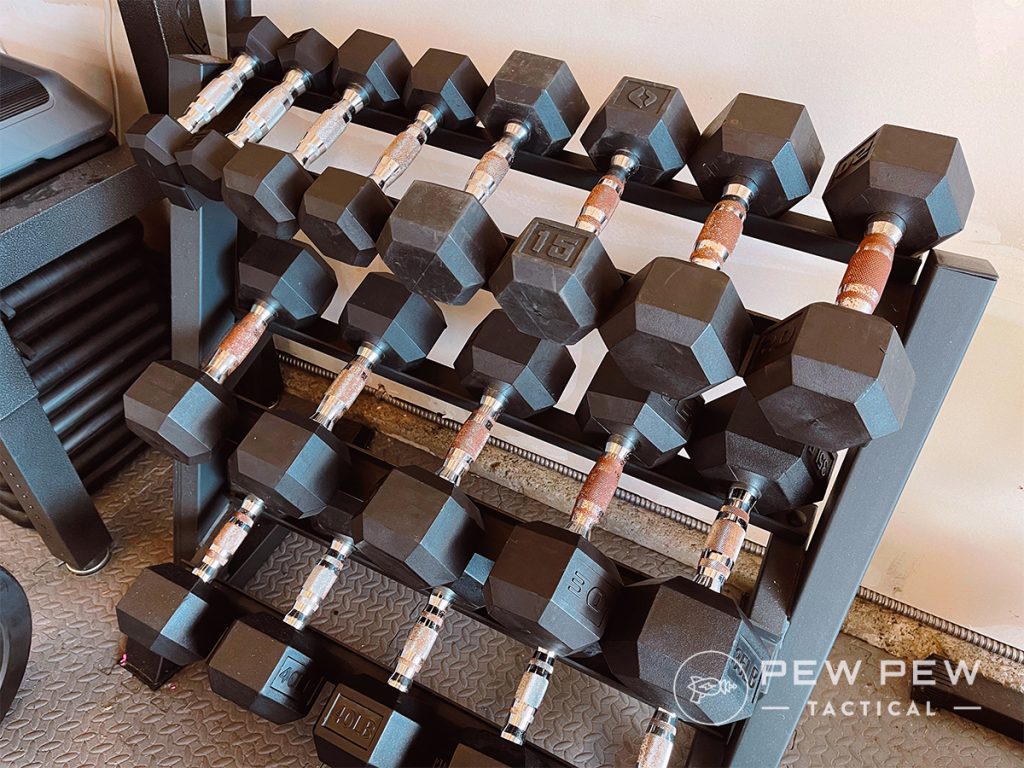
What’s your favorite way to carry at the gym? Let us know below. To learn the ins and outs of running while gunning, check out our guide on How To Run/Jog While Concealed Carrying.

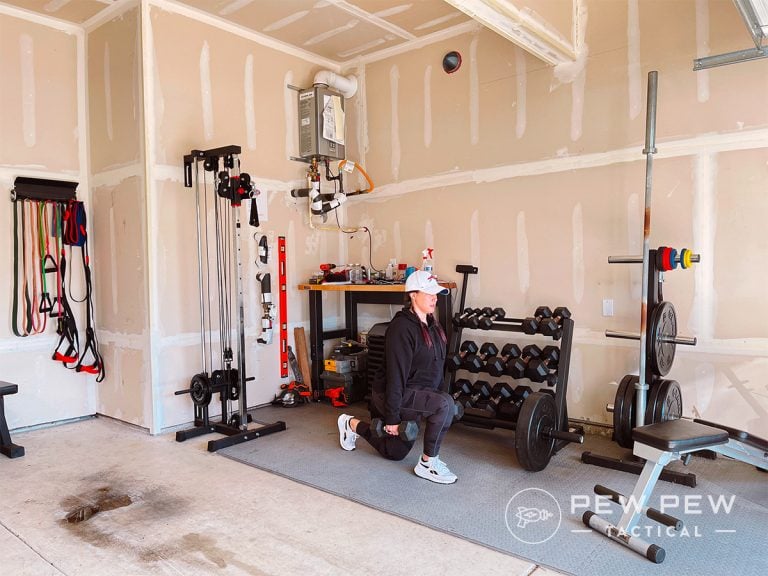
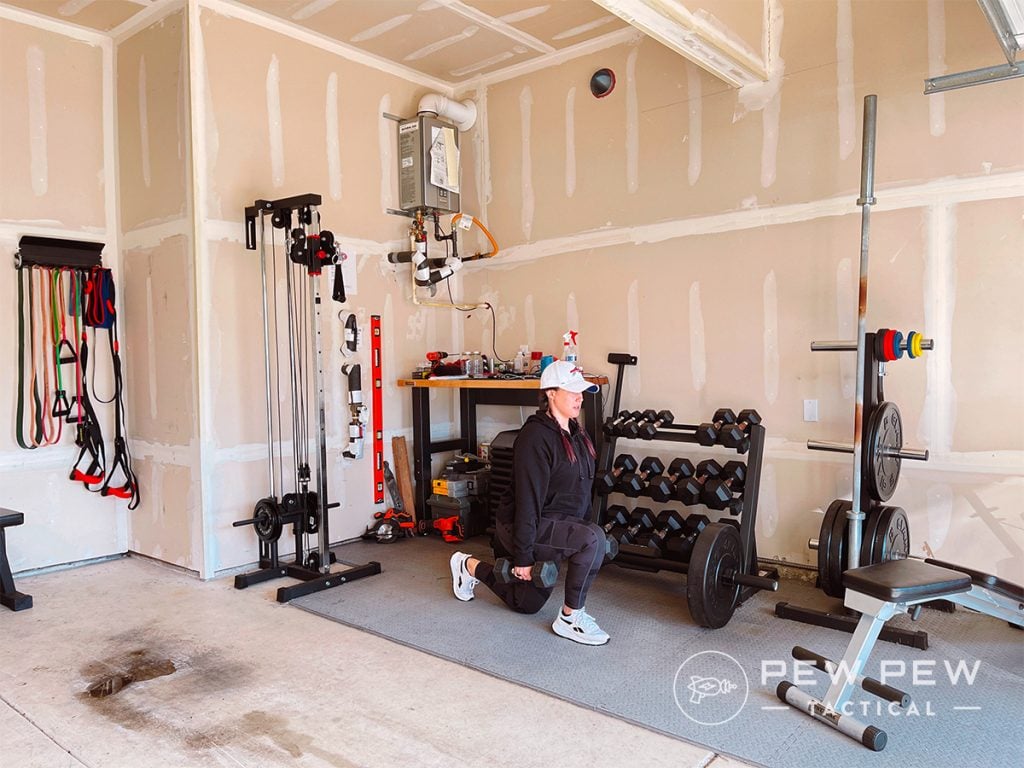


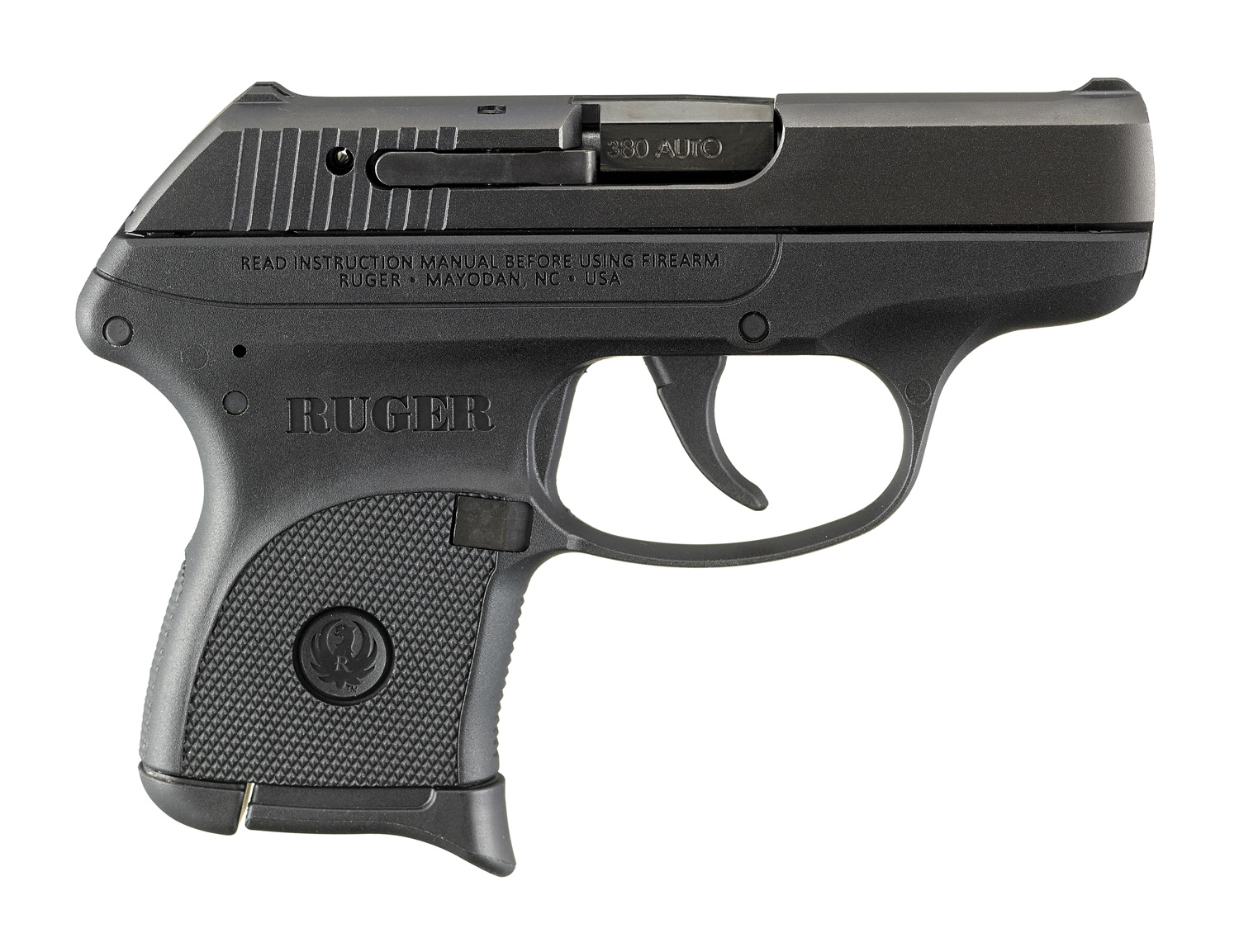


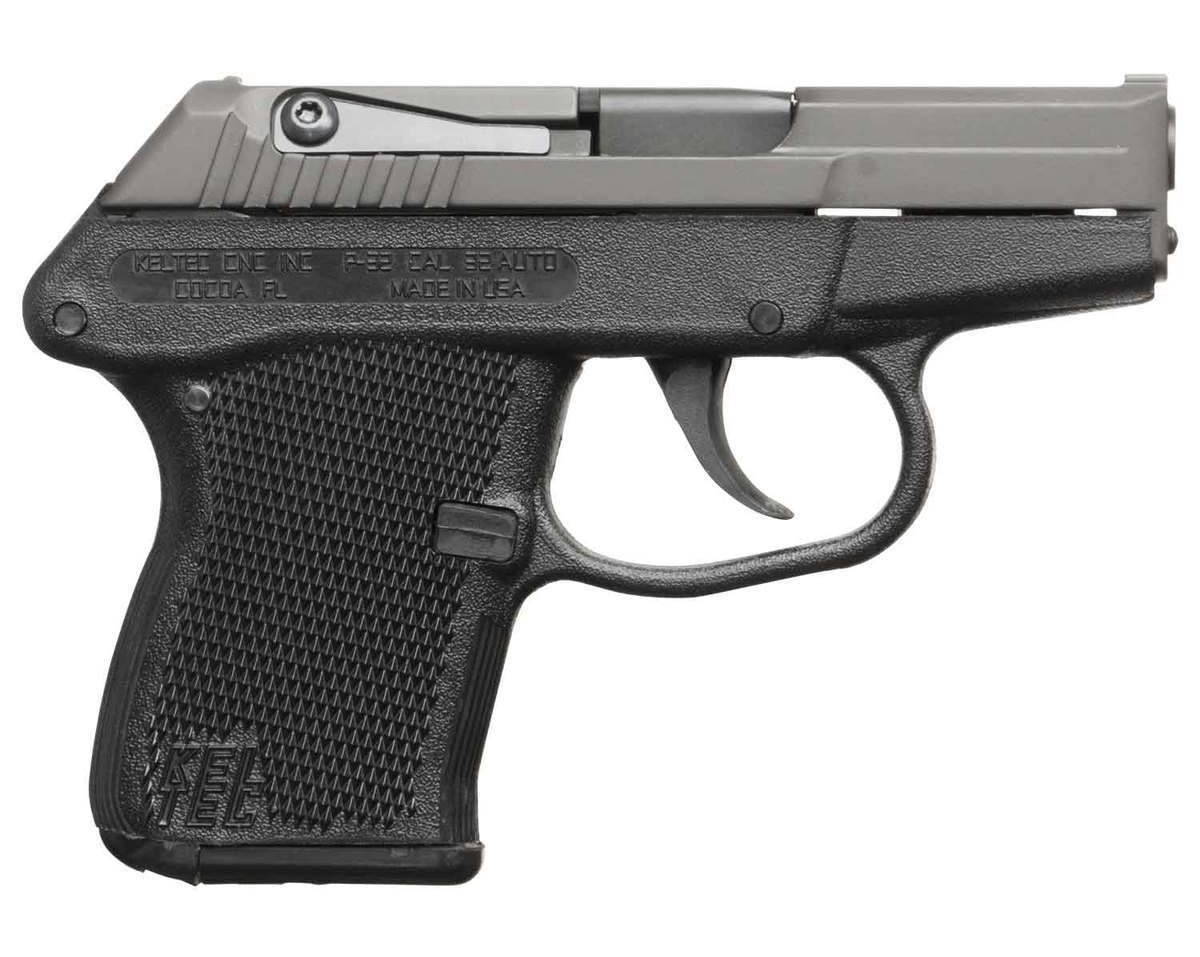


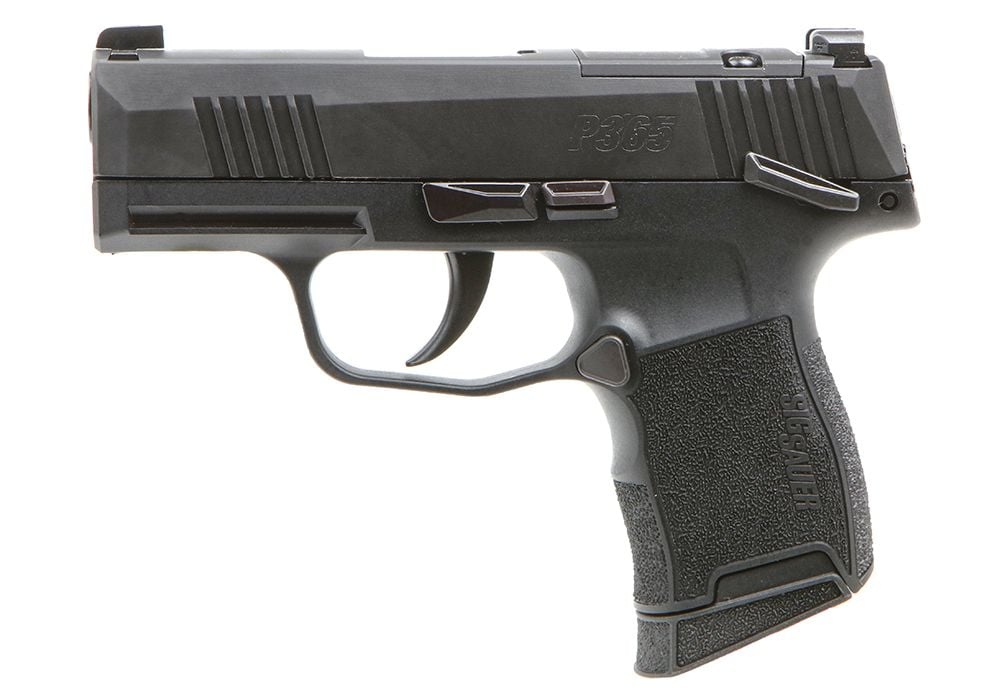







3 Leave a Reply
For the gym, or biking I pocket carry a 6 shot J Frame or an LCR. Jersey pocket carry for road biking. There is no exercise scenario that I would carry a chest rig. I mean I'm sorry, that's just laughable.
FYI about Arrowhead Tactical Apparel from their FAQ page:
"Q - Where is your apparel manufactured?
A - We currently manufacture our inventory in [Communist] China under close supervision for quality and consistency, and we are exploring American options for production as we grow in scale to be able to support the American textile industry. Your support will make this possible!”
Wish I could find some nice CCW apparel like this that already made in America.
I'm surprised you didn't cover any of the holsters by SmartCarry. Some of the most comfortable workout holsters out there. And you can also carry an extra mag, light, phone, and other valuables. Your list is incomplete. You should take a look.